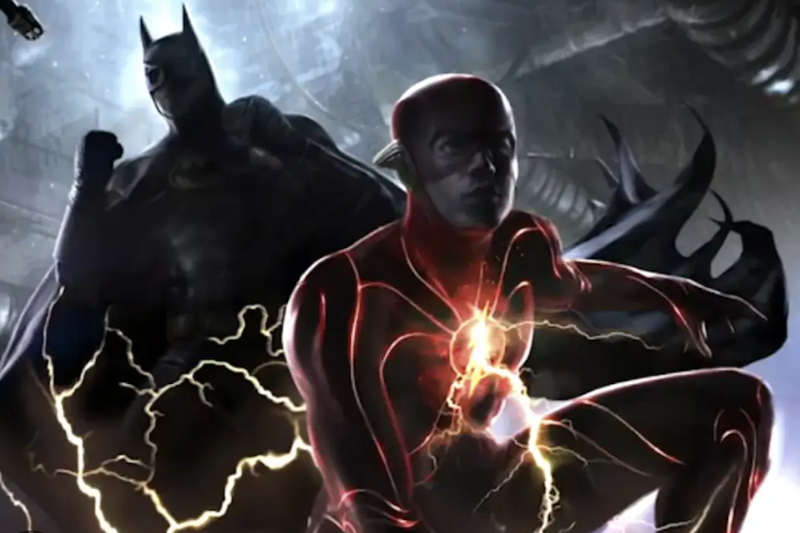Movies this month must set a new record for major releases in which the space-time continuum is altered and history rewritten.
Successive Fridays in June will have seen exhilaratingly fast timeline-hops juxtaposed to stabilizing “canon event” protection in Spider-Man: Across the Spider-Verse, an evolutionary history-reboot in Transformers: Rise of the Beasts (which for the second time in that film series also alludes to the existence of characters from a Hasbro toy line other than Transformers), the only big-screen depiction ever of the DC superheroes multiverse in The Flash, unreliably-narrated metafictional theatre about space aliens and kid geniuses fated to alter history in Wes Anderson’s Asteroid City, and finally Indiana Jones and the Dial of Destiny, in which it’s rumored the month of the Apollo 11 landing becomes the pivot point for time travel adventures in which feminist Phoebe Waller-Bridge attempts to upstage and/or erase 80-year-old Harrison Ford.
Rumor has it that fan backlash against Indy’s reported erasure led to last-minute rewrites and reshoots on that last film, but it would seem nothing short of a Hollywood writers strike can truly stop our culture’s increasingly frenetic reality-warping.
It’ll be interesting one year hence to see whether Marvel’s third Deadpool movie, also expected to be about hopping around the multiverse (since surely X-Men characters such as Deadpool and Wolverine need to meet Avengers characters now that Fox and Disney, respectively, are merged), shows any signs of lead actor/co-writer Ryan Reynolds’ comedic improv habits being reined in at the last minute: The film started shooting right around the time the unions went on strike and started punishing any films engaged in on-set rewrites. Space-time is malleable, union rules less so.
(I’ve written Justice League comics and acted in the indie film Werewolf Bitches from Outer Space—featuring Janeane Garofalo—if anyone needs a scab, by which I mean me, not Garofalo, who as a veteran of leftist Air America radio is probably anti-scab.)
Reality-warping seems like such a natural expression of our culture’s growing speed and inattention to detail that once all the writers are back on the job, I almost wouldn’t blame them for cranking out more and more stuff that feels like an avalanche of contradictory allusions and hastily-completed CGI. Given that Flash director Andy Muschietti also did the film adaptation of Stephen King’s It, I’m surprised Flash doesn’t feature Batman making some knowing wisecrack about “every reality having an evil clown or two.” Throw it all in there, wheee!
In fact, Flash lead Ezra Miller’s menacing little dance when he’s crossing the street toward Flash’s childhood home at one point in the film looks unsettlingly like something Pennywise the Dancing Clown might do in It. That’s also The Flash’s only tiny reminder that Miller’s a mentally ill criminal in real life—one who at a low point in his madness told people that he really is a multiverse-transcending messiah figure and that the film’s release would spark the unveiling of a real-life multiverse. (Perhaps time-traveling and walking through walls in two different superhero franchises—X-Men and Umbrella Academy—has contributed to mental instability in another non-binary superhero actor, since Elliot Page is suspected by some of faking a recent hate crime.)
If we’re looking for signs that, uh, real reality is imperiled, I hope it’s mere coincidence that the Flash release date is 6/16, which is also the number of the main Marvel universe over in the Marvel multiverse. And let us hope, while we’re at it, that nothing apocalyptic happens a month later when Oppenheimer (by veteran Batman director Christopher Nolan) and Barbie(from writers who depicted an “airborne toxic event” last year in White Noise just before that real-life Ohio chemical spill) come out on the same day in July. The Kubrick-Monolith-parodying trailer for Barbie had more than a little bit of a “behold the mighty missile” vibe to it as the camera rose past the gleaming form of a shining giant Barbie doll.
I’ve thought for some time that if art tends toward unfettered mixing-and-matching, it may be inevitable that within fiction, the concepts of the multiverse, magic, mutation, matrix-simulations, and media itself all start to merge. You can see hints of it already in Marvel’s Doctor Strange movies—and it’s a shame Marvel hasn’t made more use of the villain Mysterio, who blended at least a few of those concepts. There’s a reason kids’ stories so often use magic as a crutch. The writer can summon anything from a flying castle to a talking snake, so why not?
There’s a decrease in dramatic tension if reality can be undone and refashioned at any time, just as death loses a bit of its dramatic sting every time sci-fi conjures up a clone. But then again, especially with childhood-inspired franchises, the big thrill for many viewers is seeing every last item in the toy box used all at the same time, willy-nilly. Unless self-restraint and subtlety suddenly become a lot more popular, both on-screen and in everyday life—unlikely in a culture poised to cover everything in “augmented reality” illusions while performing elective surgeries—expect the avalanche of CGI and committee-written scripts set in shifting modular realities to continue.
—Todd Seavey is the author of Libertarianism for Beginners and is on Twitter at @ToddSeavey

